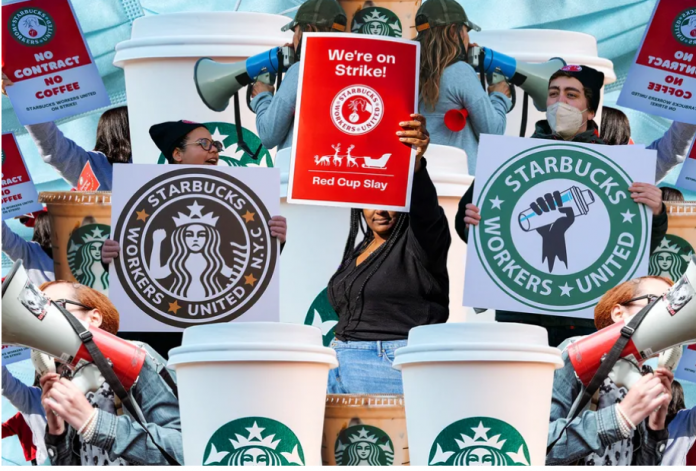In 2022, after two years of working on the frontlines of the COVID-19 pandemic, workers across the country made clear that they’d had enough, and walked off the job. This year brought an unprecedented spike in strike activity across multiple industries, but from Starbucks to Chipotle to McDonald’s, nowhere was this surge of worker power on display more prominently than in the restaurant industry.
Perhaps the biggest labor story of 2022 is that of Starbucks Workers United, a Workers United affiliated union that has organized thousands of employees at more than 250 Starbucks locations across the country. Over the past year and a half, Starbucks workers at locations across the country, from California to Massachusetts, have gone on strike in 17 states. This summer, Boston-area Starbucks employees spent more than two months on the picket line, protesting a new policy that requires workers to have a minimum availability each week. (The strike ended, as the New York Times reports, a few days after Starbucks announced the policy would not apply to unionized stores.) Starting on October 26, workers at a Starbucks Reserve Roastery in New York City walked off the job, alleging that the company had refused to deal with a bedbug infestation at the cafe, along with complaints about mold in the ice machines. Starbucks initially denied those claims, but New York state inspectors found that there was, in fact, mold in the ice machine. The strike lasted for 46 days, ending only after the union says it secured a thorough bedbug inspection and remediation, improved health and safety training, and an “increased cadence of maintenance and cleaning” in the cafe. Eater reached out to Starbucks for comment on the strike, but the company did not respond to our request.
In the most high-profile Starbucks strike, November saw baristas at more than 110 locations announced they would walk off the job on Red Cup Day, a major sales day for the company. As workers picketed outside those locations, the union handed out its own version of the chain’s famed red cups, rebranding the day as the Red Cup Rebellion.
Wages and working conditions have been key sticking points in worker strikes. In the spring, workers at a Los Angeles McDonald’s location walked out in protest of hazardous working conditions; that same month, Dollar General employees in North Carolina went on strike over low wages. Thousands of fast-food workers in California went on strike in June to demand that legislators pass AB 257, a bill that would “establish higher minimum standards for wages, working hours and conditions” for workers across the industry. A group of not-yet-unionized Taco Bell employees in Kansas City walked off the job during the lunch rush in September, citing poor wages and workplace hazards. “We need a living wage, respect, safe working conditions, and a union,” read a sign taped to the restaurant’s window.
Also in September, 1,000 food workers at San Francisco International Airport went on strike, demanding higher wages and improved health insurance. Though it only lasted three days, the airport strike resulted in $5 hourly pay increases for unionized workers, along with fully paid health insurance for workers and their families. The California fast-food worker strike drummed up support for AB 257, and on September 5, California Gov. Gavin Newsom signed the bill into law. (Perhaps not surprisingly, the fast-food industry rushed to challenge the law. Now, California voters will decide whether or not the law, called the FAST Act, will remain in effect when they head to the ballot box in November 2024.)
This uptick in strike action is the culmination of nearly three intense years of organizing and labor action in the hospitality industry as workers came together to protest their working conditions at the height of the COVID-19 pandemic. “The pandemic put a lot of pressure on in-person service workers, and the conditions made them think more intensively about the jobs that they do,” NYU professor Andrew Ross told Eater back in April. “They realized, ‘Wow, I’m an essential worker, and essential workers should have essential rights.’”
Only time will tell whether or not these incredible gains in restaurant industry union momentum will continue, or if the movement will run out of steam as a potential recession looms on the horizon. What is clear, though, is that restaurant workers across the country are fed up with being treated poorly on the job, and are prepared to strike to secure the wages and benefits that they deserve.
Published By: Eater




